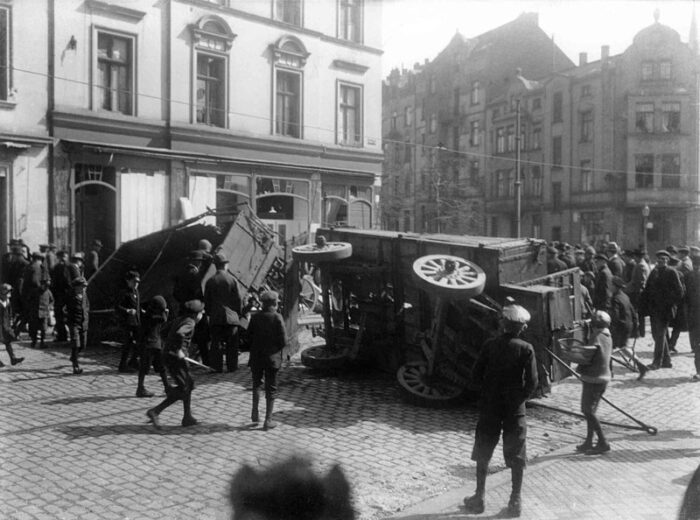dd
by Susan Ronald
In the following excerpt from Hitler’s Aristocrats, author Susan Ronald discusses the Weimar Republic and the political environment that enabled the rise of Hitler and fascism in post-World War I Germany.
Many believe the rise of fascism was a direct response to the October 1917 Bolshevik revolution and subsequent Russian civil wars. When Czar Nicholas II was deposed in the February 1917 revolution, the Allies hoped that the new Soviet government under Alexander Kerensky and the Russian Duma (parliament) would be more democratic than the Romanov totalitarian state. Within six months, Vladimir Lenin’s 1917 October revolution toppled Kerensky’s provisional Soviet government, making hopes for democracy futile.
During these critical six months in 1917, the war raged on in the east. The Treaty of Brest-Litovsk in March 1918, which removed Russia (now called the Soviet Union) from the war, had been hailed as a victory for the Kaiser’s imperial army. Once Lenin successfully secured power for communism, a human wave of aristocratic White Russian émigrés flooded into Europe’s capitals, bringing with them their notions of superiority and opulence, knowledge of how to reach accommodation within a totalitarian state, and unremitting anti-Semitism. Many White Russian émigrés would become key propagandists for Hitler.
They instilled their visceral hatred for the communists into the Nazi creed, believing that “the myth of a mysterious Jewish-Masonic-Bolshevik plot” was behind the toppling of the Russian, German, and Austro-Hungarian empires. This was the first big lie. It was the White émigrés who exported their revulsion of Jews and the fake pamphlet The Protocols of the Elders of Zion. What is easily forgotten today is that many of these White émigrés were Russian by nationality, but Baltic German, Lithuanian, Latvian, or Ukrainian by heritage and culture. Among the White émigré adventurers who most influenced Hitler in those early days were Alfred Rosenberg (later the ideologue of the Nazi Party) and Max Erwin von Scheubner-Richter (who championed Hitler’s drive toward the east and other foreign policy decisions) through their völkisch organization, the Aufbau Vereinigung. Other members of the Aufbau included General Erich Ludendorff and Hitler’s friend and publisher, Max Amann.
In truth, most Germans felt cheated by the peace, with many aristocrats and frontline soldiers alike hoping for a resurgence of pan-Germanism. As early as 1920, outlawed underground paramilitary organizations were formed throughout Germany from the enormous remnant of the imperial army. Those who were attracted to Bolshevism were labeled the enemies of German reconstruction. A speaker at a paramilitary rally in Regensburg encapsulated the right’s position: “Friend and foe shall know that in future one must take a position and show his colors, whether left—Bolshevism—or right Reconstruction. There is no middle position.” Reconstruction soon equated Nazism. It was the Allied inability to understand the German viewpoint that led to the immediate failure of the peace. Given this history, it is no wonder that, without effective leadership throughout the Weimar era and the Gothic mindset that refused to be vanquished, a Hitler would rise into the vacuum at the top.

The communist-inspired Spartacist uprising of 1919 predictably led to armed outrages by Freikorps groups aimed at defending Germany against communism. Wildcat strikes and bloodthirsty atrocities became a common feature of life throughout Germany in the ensuing months. The murders and reprisals continued until May 1919. And yet the Freikorps violence was often mistaken by many Germans as the intervention of their disbanded imperial army acting to protect the nation from bolshevism. Few recognized they were simply dangerous vigilantes.
So where were the German aristocracy and diplomats who might have found a middle way? For most, the new Weimar Republic made them wonder if they still had a place in this alien country. Their royal, princely, and noble properties had been “restructured.” The Wittelsbachs in Bavaria and the Von Hesses at Kassel (also related to the British royal family) were forced to cede vast swathes of their lands to the German state. What lands remained for their benefit had to be administered at arms’ length through independent foundations. Their German bank accounts were frozen, and only their art, jewels, and internationally convertible investments could be relied on to rebuild their fortunes. Since property had always been the hallmark of royalty and nobility, the German aristocrats, just like their Austrian and Hungarian counterparts, suffered a nosedive in their wealth, social standing, political power, and economic future. Most stared helplessly at a bleak horizon.
In fact, Weimar had been foisted onto the vanquished nation. It represented a new Germany with a dead imperial past, dead traditions, and no road map toward democracy. The German nobility had been devastated by the war of 1914–18, and like the Hungarians and Austrians, they were deeply aggrieved by the transformations they had been made to endure. Many German officers on the Western Front (most of noble birth) and the majority of common frontline soldiers—like Corporal Adolf Hitler—believed Germany had not lost in the West. With just short of six million men demobilized, and an approved German standing army of only one hundred thousand soldiers, the mind boggles that the Allies believed these men would not take up arms to rectify what they saw as an unjust peace.
The “peace” festered and infected German thinking. To paraphrase the psychoanalyst Carl Jung, from the “disorder a secret order” was born. In Mein Kampf, first published in July 1925, Hitler blamed the Jews for spreading the lie that General Erich Ludendorff lost the war in the West. In retaliation, he advocated that only “the big lie” could work against Germany’s enemies since “in the big lie there is always a certain force of credibility” that would prove irresistible to the masses, who more readily “fall victims to the big lie than the small lie.” It became a compelling argument to a defeated nation.
Yet France remained vengeful, with some good reason. Not only had it been invaded in 1871 by Bismarck’s newly unified Germany and lost Alsace-Lorraine but also most of the war of 1914–18 had been fought on French soil. From the British and American viewpoints, Germany had begun the war using the excuse of Archduke Franz Ferdinand’s assassination in Sarajevo to promote pan-Germanism to dominate Europe. They also continued to fight in the East long after Russia had quit the field of battle. And so the Allies compelled the leaders of Weimar to sign the Versailles peace treaty giving Germans the “sole fault” or Alleinschulde for the hostilities. Any future “military freedom” (Wehrfreiheit) or self-determination for Germany was out of the question.
Copyright © 2023 by Susan Ronald

Born and raised in the United States, Susan Ronald is a British-American biographer and historian of more than half a dozen books, including Conde Nast, The Ambassador, A Dangerous Woman, Hitler’s Art Thief, and Heretic Queen. She lives in rural England with her writer husband.
